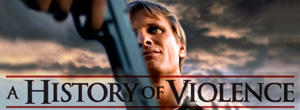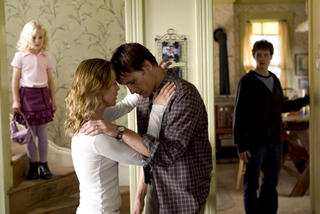HISTORY teaches a dark lesson
 A HISTORY OF VIOLENCE arrives in theatres as one of the year’s most acclaimed films. While it’s not a great film, it definitely qualifies as good, and it’s the kind of film you look back on with great respect. For director David Cronenberg it’s almost a mainstream picture, certainly easier to watch then such recent efforts as SPIDER, NAKED LUNCH and CRASH (the other CRASH). However, take the ‘R’ rating seriously. Some of the sex and violence is far more graphic than you’re probably used to seeing.
A HISTORY OF VIOLENCE arrives in theatres as one of the year’s most acclaimed films. While it’s not a great film, it definitely qualifies as good, and it’s the kind of film you look back on with great respect. For director David Cronenberg it’s almost a mainstream picture, certainly easier to watch then such recent efforts as SPIDER, NAKED LUNCH and CRASH (the other CRASH). However, take the ‘R’ rating seriously. Some of the sex and violence is far more graphic than you’re probably used to seeing.Look back through the films of Cronenberg and you’ll see he’s drawn to stories of normal, decent people reacting to harsh outside intrusions. While his early work stays comfortably within the niche boundaries of Horror and Science Fiction, more recent efforts take a difficult art-house approach.
 VIOLENCE is based on a graphic novel by John Wagner , and Vincent Locke, and I found it to be similar in a lot of ways to ROAD TO PERDITION, another graphic novel about violence, gangsters and families made into a movie. (While VIOLENCE may currently have better reviews, I think PERDITION is clearly a stronger movie.) Both films take place primarily in America’s rural neighborhoods, both center on fathers coming to grips with violence in their lives, and both play less as an action picture than a character drama that builds every half-hour to a violent confrontation.
VIOLENCE is based on a graphic novel by John Wagner , and Vincent Locke, and I found it to be similar in a lot of ways to ROAD TO PERDITION, another graphic novel about violence, gangsters and families made into a movie. (While VIOLENCE may currently have better reviews, I think PERDITION is clearly a stronger movie.) Both films take place primarily in America’s rural neighborhoods, both center on fathers coming to grips with violence in their lives, and both play less as an action picture than a character drama that builds every half-hour to a violent confrontation.Cronenberg has said in interviews that he hates the way movies portray violence, because it always looks cool when it should be off-putting. Well, he demonstrates what he means here, because there are a few shots where the camera punches in for a close up of somebody who’s been physically damaged, and they’re some of the more gruesome images I’ve seen in a movie. This is the first film to realistically show not only how you can kill a man by driving his nose into his skull, but also what that man’s face would look like.
 If you’ve seen the trailer and commercials for this picture, the studio is doing a great disservice. The story could have been far less spoiled and more suspenseful if described like this:
If you’ve seen the trailer and commercials for this picture, the studio is doing a great disservice. The story could have been far less spoiled and more suspenseful if described like this:“Tom Stall (Viggo Mortensen) foils a vicious, attempted robbery in a diner and becomes a local hero. Gangsters show up, insisting Tom is actually a murderer in hiding. Now, Tom must protect his family from vicious killers who have come seeking revenge for violent acts he never committed.”
 Viggo is very good in the lead role, but this is far from an Oscar-worthy performance. I’m getting a little tired of how much he underplays his characters. For Aragorn in LORD OF THE RINGS, underplaying is an inspired choice, but here I couldn’t help but feel there was more to bring to the character if he just dialed up the energy a bit.
Viggo is very good in the lead role, but this is far from an Oscar-worthy performance. I’m getting a little tired of how much he underplays his characters. For Aragorn in LORD OF THE RINGS, underplaying is an inspired choice, but here I couldn’t help but feel there was more to bring to the character if he just dialed up the energy a bit. This is more the role Tom Hanks was looking for when he made ROAD TO PERDITION. He would have excelled here. The problem with PERDITION was that Hanks was playing a killer who wanted to reform and be likable, which is too easy for the immensely likable star. Tom Stall starts as a likable everyman, until the plot pushes him into increasingly brutal situations.
 I’m reading a lot of praise for William Hurt, who has one of those roles where he’s only in the film for a few minutes, but it’s a very important part of the movie. Honestly, I found Hurt to be a bit hammy and his accent was forced. The always reliable Ed Harris does a much better job as the lead villain. While Hurt works hard to remind us he can still be a compelling actor, Harris relaxes into his part and allows the big moments to come to him.
I’m reading a lot of praise for William Hurt, who has one of those roles where he’s only in the film for a few minutes, but it’s a very important part of the movie. Honestly, I found Hurt to be a bit hammy and his accent was forced. The always reliable Ed Harris does a much better job as the lead villain. While Hurt works hard to remind us he can still be a compelling actor, Harris relaxes into his part and allows the big moments to come to him. The best thing about William Hurt’s scene is the way he’s framed. There’s a shot in the film where Hurt leans forward in his chair and the camera pushes in so that his head takes up the entire right frame. It almost looks like a 3-D effect with Hurt’s wide, expressive eyes and giant slope of a forehead towering out from the screen.
The best thing about William Hurt’s scene is the way he’s framed. There’s a shot in the film where Hurt leans forward in his chair and the camera pushes in so that his head takes up the entire right frame. It almost looks like a 3-D effect with Hurt’s wide, expressive eyes and giant slope of a forehead towering out from the screen.I hate to do this to a child, but the actress who plays Viggo’s daughter is terrible. Luckily she’s only important in a couple of scenes, but one of them is right in the beginning and in a time of good child actors, there’s just no excuse for such a bad performance.
A HISTORY OF VIOLENCE suffers a bit from being episodic and a little too simple. And while it’s faster than Cronenberg’s recent films, it’s still kind of slow. The film often feels just on the verge of going nowhere, but manages to be moderately compelling and effective. A must for Cronenberg fans (though not in the same league as NAKED LUNCH or THE FLY) this is the kind of picture that can play well beyond the art house, but is still a little too small and dry for mass consumption.




0 Comments:
Post a Comment
<< Home